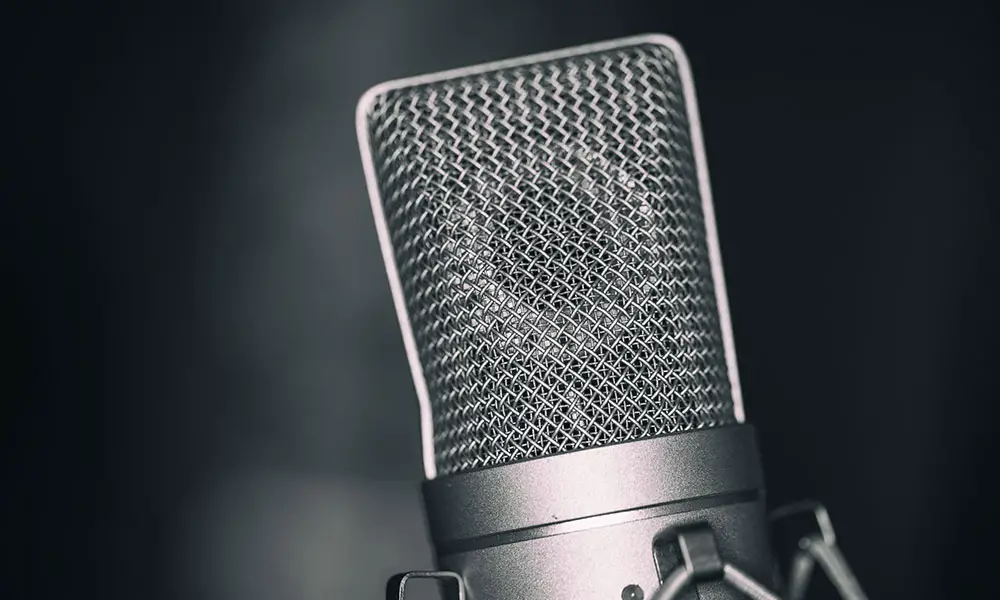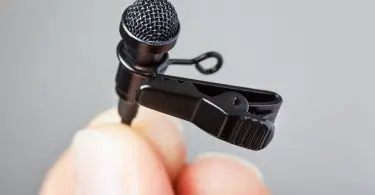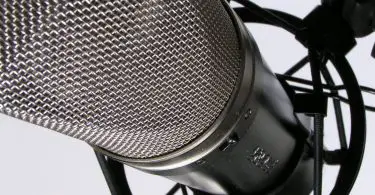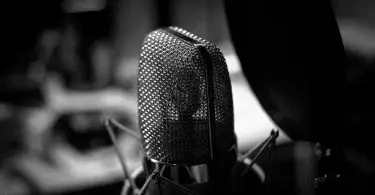The world is changing quickly. The way that we communicate with each other and the world has more outlets than ever before.
Podcasts, YouTube, and GoToMeeting have changed entertainment and business communication, and technology has been working hard to keep up with it.
From hours of research and testing, we’ve determined the best all-around mic for this new age.

Credit: Blue
Top Pick: Blue Snowball
Buy from AmazonIn our testing, we got crisp and clean recordings without distortion or feedback. The Snowball is perfect for all types of recording, whether it is podcasts, business calls, or YouTube. It was the easiest to setup and use, you can record right out of the box in no time.
Why a USB Microphone?
USB microphones are a great way to connect to any digital device with recording capability through a USB connection.
USB microphones have been very popular due to their plug ‘n’ play convenience, and they don’t require extra audio equipment that plugs into the computer.
All you need is a laptop or computer and you are set. Here are a few tips on what to look for in a good USB microphone and a few reviews to help you in your search.
Having been a musician for over thirty years, it has been interesting to see how technology has helped change recording throughout the years.
With these great little USB microphones, it makes songwriting and recording easy for musicians, and they are very affordable.
If you are just starting out with home recording, these can be an inexpensive and easy way to set up your own little studio.
USB Microphones vs Traditional
When you compare a USB mic to a typical mic, you will notice that there are advantages and disadvantages to both. A big advantage of the USB mic is that you don’t need extra equipment to connect it to your computer.
You should be fine as long as you have DAW software on a computer, laptop, or a USB-equipped audio recording device.
There is a digital interface that is built into the housing of USB mics which is a lot more cost effective that purchasing a separate interface and mic.
If you are on a budget, this can be a great way to make recordings without shelling out a lot of cash.
There are some limitations to the USB microphone including difficulty finding a USB input on an audio interface or mixing board, although several USB mics now have extra XLR connectors to combat this issue.
You will also find greater EQ and mixing control with an audio interface or mixing board. Some DAW’s are also working on that issue by providing more control over the sound of the mic.
Digital Audio Conversion
Mixing boards and audio interfaces also convert analog signals from microphones to digital data allowing computers to process it.
Usually, this ability is built into the USB mic, so it is important to make sure the mic you are looking at has this feature as it will affect your bit depth, latency, and sample rate.
Sample Rate
The sample rate is the speed that is measured in kHz (kilohertz).
When you have captured a sample rate of a minimum of 44.1kHz, you are at the spectrum of frequency that humans can hear, which is also the rate this is used on CDs.
You need to make sure your microphone will support this at the minimum while professional equipment will use a higher rate at either 48kHz and 96kHz sample rates. (Presonus)
Bit Depth
The bit depth tells you how many information bits each sample has in it, which also lets you know the resolution or detail of the recording.
A minimum amount your microphone should be is a 16-bit depth, which is also what a CD is at, while professional audio equipment will use 24-bit samples that can be produced by some USB microphones.
Latency
This is the delay between the time it takes for a signal to be converted into digital signals and played through monitoring gear after the sound has reached your microphone.
Basically, the lower the latency, the higher quality a USB mic you have.
Some USB mics add a headphone output for real-time monitoring while recording to deal with latency. (Audio Technica Blog)
Microphone Diaphragm Size
The diaphragm is the part of the mic that first reacts to the input of sound.
Good all-around mics have large diaphragms that have higher sensitivity and pick up low frequencies better.
Small-diaphragm mics are good for acoustic instruments that have a lot of overtones and resonances as well as high-pitched instruments.
Mic Polar Patterns
Microphones are designed to capture sound from different directions.
There are microphones that pick up sound from all directions as well as mics that only capture sound from one direction. (Shure)
Cardioid Mics
A cardioid mic has a heart-shaped pickup pattern that captures sound from the front, but can pick up some sound from the side.
These are used a lot in recording studios and when you don’t want to pick up other sounds in the room.
Omnidirectional Mics
When you want to capture all the sounds in the room as well as the source, omnidirectional microphones are the best choice.
This type of mic is also great for recording several voices or acoustic instruments at once.
Multi-Pattern Mics
When you need a mic that has a switchable pickup pattern, a multi-pattern microphone will work.
They are also known as multi-directional or switchable mics.
USB Mic Controls
You will find controls that are not normally part of a typical mic in USB microphones that have integrated functions that are normally found in preamps and audio interfaces.
They should also include a volume control so you change the microphone output, and some even have polar patterns selectors.
Other USB mics may have the following:
Pad Control – This is a switch for weakening the microphone’s output giving you headroom for volume spikes to stop distortion and overload.
Monitor Mix – In certain mics, there is real-time monitoring that lets you adjust the recorded signal in relation to previously recorded tracks.
Mute Control – Stops the microphone signal.
Low-Cut Filter – Stops low frequencies and getting rid of stage noise and rumble.
EQ Modes – Normally there aren’t detailed, multiband EQ’s on a microphone, but these can have a mode switch that EQ the preamp on the microphone for different recording needs.
The Competition
After hours of testing and research, here's the final competition.
| Instrument | Rating | Current Pricing |
|---|---|---|
Blue Snowball USB Microphone | Compatible with both Mac and PC and with the plug-and-play design, and you don’t need extra drivers, plus you can record right out of the box |  |
Blue Snowflake USB Microphone | Can also pivot and rotate to make positioning the mic a breeze |  |
eBerry Plug and Play Home Studio | It is compact and portable with an adjustable stand that can be set for your comfort level |  |
CAD U37 | Great option to record instruments and vocals plus make voiceovers and podcasts |  |
Rode Podcaster | Has an internal pop filter that was created to lessen plosives sounds that can otherwise distort your audio output and overwork the microphone capsule |  |
Blue Microphones Yeti | Allows you to use both right and left channels, so you can easily capture a realistic sound. |  |
Rode NT-USB | Includes a premium pop-filter that fits right on to the base of the mic that will position the filter the perfect distance from the capsule |  |
Samson Go Mic | Capable of capturing the sound in an entire room, so it is perfect for webcasting or online meetings with several people in one location |  |
Top Pick: Blue Snowball

Credit: Blue
If you are looking to create studio-quality recordings with a USB microphone, check out the Blue Microphone’s Snowball with its superb sound capturing capabilities.
You’ll get crisp and clean recordings without distortion or feedback with the award-winning circuit design and dual-capsule.
The Blue Snowball features a unique pattern switch that lets you switch back and forth between three different settings.
It is compatible with both Mac and PC and with the plug-and-play design, and you don’t need extra drivers, plus you can record right out of the box.
There are three pattern modes to record with including the Omnidirectional Mode when you want to pick up sound evenly from all directions like a live recording.
The Cardioid mode is perfect for vocal work and podcasts or any sound source that is put right in front of the microphone giving the recordings a full-bodied and rich sound.
The Cardioid mode with -10 dB PAD gives you the same features as the cardioid mode, but includes a -10 dB reduction that lets you record loud sound with high fidelity.
The Snowball also has a great retro look with its brushed-aluminum frame and a metal grille that works well with any computer system.
Sound quality is improved with an adjustable tripod that allows you to position your microphone close to the sound source, plus it has a LED indicator that lets you know when the mic is powered on.
This is also a very easy microphone to set up and use. You simply plug it into a USB port in your computer using the included USB cable and then, once it is calibrated to your computer’s operating system, you are all set to record.
The Snowball needs a minimum of 64 MB of RAM and works with Mac OS, Windows 7, Windows 8, Windows Vista, and Windows XP.
It is able to capture studio-quality recordings, and it has superb sound capture capabilities for a USB microphone. Free of distortion and feedback, the Snowball gives you crisp and clean with a unique pattern switch that lets you switch back and forth for added versatility in your recordings.
The Snowball has become a standard go-to mic that doesn’t take up a lot of space and sounds awesome.
This is the ideal microphone for those that have never used one before, and it is available for only $70.
Pros
Easy to use and doesn’t use a lot of space
Good for all types of recording like podcasts and youtube
Great starter mic, ready to use straight out of the box
Cons
Sound level can be on the low side for some people
Other USB Mics to Consider:
Blue Snowflake

Credit: Blue
When you need a professional quality portable mic, the Blue Snowflake Microphone has a USB bus powered capsule that features a class compliant design to easily plug in and play on either a PC or a Mac.
It doesn’t just look cool, but it is very functional and can easily be folded and transported in a single compact case or your pocket.
The case can also work as a stand on your desktop or as a laptop clip making the Snowflake perfect for Skype, podcasts, home video narration, or writing songs on the go.
With the Snowflake’s unique design, you can place the mic on a flat surface next to your computer or you can mount it onto the screen of almost any laptop.
It can also pivot and rotate to make positioning the mic a breeze. It also has easy storage when not in use with the included case that protects the mic from getting damaged.
The Blue Snowflake is pretty close to ideal when you are talking about desktop recording. It includes a USB cable with the case and is available for only $55.
Pros
Don’t need a headset or to hold onto a mic
Better sound quality than a built-in microphone
Comes with a built-in soundcard
Cons
Easily picks up ambient sound
eBerry Plug and Play Home Studio

Credit: Microphone Store
If you have a budget and are just looking for a microphone that lets you be heard clearly, the eBerry Plug and Play USB microphone is a great option for you.
It works well for podcast hosts, game playing, or chatting via Skype, and it is just a very affordable and simple to use microphone.
It is simple to plug in and use on any plug-and-play enabled Mac or PC device. It is compact and portable with an adjustable stand that can be set for your comfort level.
You won’t be disappointed with this plug-and-play USB Microphone at only $11.
Pros
Easy to plug and in and use immediately
Has an adjustable neck that is easy to position
Includes a nice long 4 ft USB cord
Cons
Starts to may a loud whining noise if left on too long
CAD U37

Credit: Audio Incorporated
If you are looking for an inexpensive, studio-quality mic, the CAD U37 USB side-address condenser microphone needs to be on your list to check out. It records via a USB cable directly to your computer, and it is a great option to record instruments and vocals plus make voiceovers and podcasts.
The CAD U37 works well with Mac OS and Windows operating systems that can be easily plugged into your computer and is ready to record. There are two switches on the front with one that lets you decrease your microphone’s sensitivity, so you have clear sound quality from very loud sounds.
The other switch lessens the pickup from deep bass sounds, and it has the capability of removing noise from ventilation, wind and reduces low frequencies that are often found in recordings.
The plug n play features allow you to immediately create your own audio by simply plugging in the mic to an available USB port.
With the U37, you can elevate your gaming, social media, or home studio sessions with studio quality audio that gives you limitless options and creative control at your fingertips.
The U37 includes extended transient response, frequency response, and a smooth interpretation to make it perfect for speeches, singing, or and recording instruments. It has the appearance of an authentic studio mic, and since it is very inexpensive at only $40, your first thought is that it is probably cheaply made.
You will be pleasantly surprised to find out that it isn’t, and it also includes a USB cable and a tripod stand.
Pros
Lightweight with good sound quality
Easy to plug in, works right away
Comes with a stand
Cons
The plastic body is a little on the flimsy side
Rode Podcaster

Credit: RØDE Microphones
It is awesome when you find a mic that can combine the ease of USB connectivity with broadcast-quality audio.
This allows you to record directly to your computer without requiring needing a Podcaster that internally processes the analogue-to-digital conversions, a 48 kHz sampling A/D converter, and an audiophile quality 18-bit resolution.
You will have zero-latency monitoring with the headphone output found on the microphone body giving you the ability to hear precisely what is being recorded without echo or delay.
It also has an internal pop filter that was created to lessen plosives sounds that can otherwise distort your audio output and overwork the microphone capsule.
The Podcaster is bus powered and includes a LED light to let you know when it is operating, plus it is fully compatible with Max OS X, Windows 8, Windows 7, and several Linux distributions.
If you make podcasts, YouTube videos, corporate videos, vodcasts, or you use voice recognition software and any production application that you need professional sounding voice-overs for, the Podcaster is perfect for any of these functions.
It can also be used as a handy demo microphone for songwriters and musicians that want high-quality sound with the convenience of a USB microphone.
If you have an Apple iPad with the iPad Camera Connection Kit, the Podcaster will help you create high-quality recordings with different iPad apps like Garageband.
It comes with an RM2 microphone ring mount that is sturdy, plus you can also purchase a PSA1 boom arm or PSM1 shock mount professional projects.
With the low-cut filter, the on-air indicator light, the low-noise performance, and the built-in pop filter, you are getting a lot of features than just a simple USB mic.
It is plug-in ready, and since most people that use USB mics that very little acoustic treatments set up in their home studio, you need a mic that’s going to give you good sound under those conditions.
The zero-latency headphone jack is a must have when you are doing any type of music recording making this a great feature to have on a USB mic that runs in the low $200 range.
Pros
Good price, especially in comparison to other XLR mics
Great sound, work automatically on a Mac
Well-made, durable
Cons
Not possible to use a voice processor or mixer
Blue Microphones Yeti

Credit: Blue
To create unmatched recordings straight to your computer, the Blue Microphone’s Yeti USB Microphone uses a proprietary tri-capsule technology that gives you perfect studio-quality recordings.
It has four pattern settings that allow you to record instruments, vocals, or interviews that would otherwise need several microphones to do.
You can record right out of the box with easy dials to control pattern selection, microphone gain, instant mute, and headphone volume, pattern selection, instant mute, and microphone gain.
Included omnidirectional mode capture sound well from all directions and works best when recording live sessions.
The bidirectional mode allows you to capture sound from both the rear and front of the microphone, and it is meant to pick up the smallest distinction in an interview or recording a musical instrument.
The Yeti allows you to easily control every aspect of your recording process and easily reduces feedback and distortion with a simple adjustment of the gain control.
The stereo mode allows you to use both right and left channels, so you can easily capture a realistic sound.
Inspired by the designs of class recording equipment, the Yeti has a retro style appearance that works with any computer system that recalls the days of old-time microphones.
Since the microphone is hinged, it is easy to adjust and pivot to place it closer to the sound source making your sound quality better. Once you have it in your preferred position, it can be screwed securely in place, plus it folds down for easy portability.
When you need a mic that gives you more than just a simple voice recording, the Yeti gives you the versatility that you would otherwise need several microphones to accomplish.
The tri-capsule array lets you record in stereo with the three standard polar patterns including figure-8, cardioid, and omnidirectional. All this versatility is available around $100.
Pros
Easy to setup and use
Doesn’t need a preamp or other equipment
Looks nice, not expensive
Cons
The base is able to pick up vibrations from other computer parts
Rode NT-USB

Credit: RØDE Microphones
For a versatile side-address microphone, the Rode NT-USB is perfect for capturing vocals and musical performances as well as voice-overs and podcasts.
Any recording applications that accept an external microphone like the Apple iPad, Windows, and Mac OS based computers, but it may need the appropriate USB connection adaptor.
It also features stereo headphone monitoring jack with zero-latency that allows real-time monitoring, plus adjustable dials monitor and mix between the microphone and the computer/iPad audio.
It also includes a premium pop-filter that fits right on to the base of the mic that will position the filter the perfect distance from the capsule.
The Rode NT-USB also includes a desktop tripod stand that lets the mic sit on the tabletop at a comfortable height, a storage pouch, and a high-quality stand mount that comes with a 3/8 inch thread that is an industry standard.
This is a simple to use USB mic that lets you easily tune the balance from live and backing tracks to the exactly where you prefer.
The Rode NT-USB is one of those mics that is just a straightforward convenient USB mic without any gimmicks, and it is available for around $170.
Pros
Quick and easy to set up
Great at close range and for live streaming
Doesn’t require software
Cons
Doesn’t have a hard mute button
Samson Go Mic

Credit: Samson Technologies Corp
Portable microphones are perfect if you are on the go a lot and works well for many different projects like podcasts, recording music, or even field recording. It can even be used with voice recognition software, voice over protocol, iChat, and webcasting.
It easily clips onto your laptop or sits inconspicuously on your desk, plus it is totally compatible with Windows or Mac OS with its easy plug and play operation.
The Go Mic gives you clear, professional sound thanks to its careful engineering and high-quality components. You can switch from omni and cardioid polar patterns, so you can pick the preferred pattern for your current project.
The cardioid pickup pattern is tightly focused, and it is a good option for recording vocal, podcast, or acoustic guitar.
The omnidirectional pattern is capable of capturing the sound in an entire room, so it is perfect for webcasting or online meetings with several people in one location.
This is a compact mic with a multi-purpose design with a resolution of 16-bit/44.1 kHz and a frequency response of 20 Hz – 18 kHz.
The Go Mic is a versatile computer-based mic that gives you a convenient recording solution and, if you make podcasts, this mic will satisfy the growing standards for high-quality audio and ease of use.
You can record right into your favorite software program with CD quality results, and the Go Mic works with both Macs and PCs.
If you communicate frequently on VoIP, Skype, or iChat, the Go Mic gives you great clarity which is great when you are on the road or have online meetings.
If you do voiceover work, audio quality is important and the Go Mic has the impeccable sound quality you need.
This is an inexpensive USB mic at only $40 that can help you take your recording quality to the next level.
Pros
Has convenient no-latency monitoring
Good sensitivity, good for high volume projects
Clean and clear sound, handy stand
Cons
Not as durable as other mics
Sources
- http://www.presonus.com/news/articles/sample-rate-and-bit-depth
- http://www.shure.eu/support_download/educational_content/microphones-basics/microphone_polar_patterns
- http://blog.audio-technica.com/audio-solutions-question-week-im-hearing-delay-usb-audio-device-normal/







Start the discussion at talk.hearthemusicplay.com